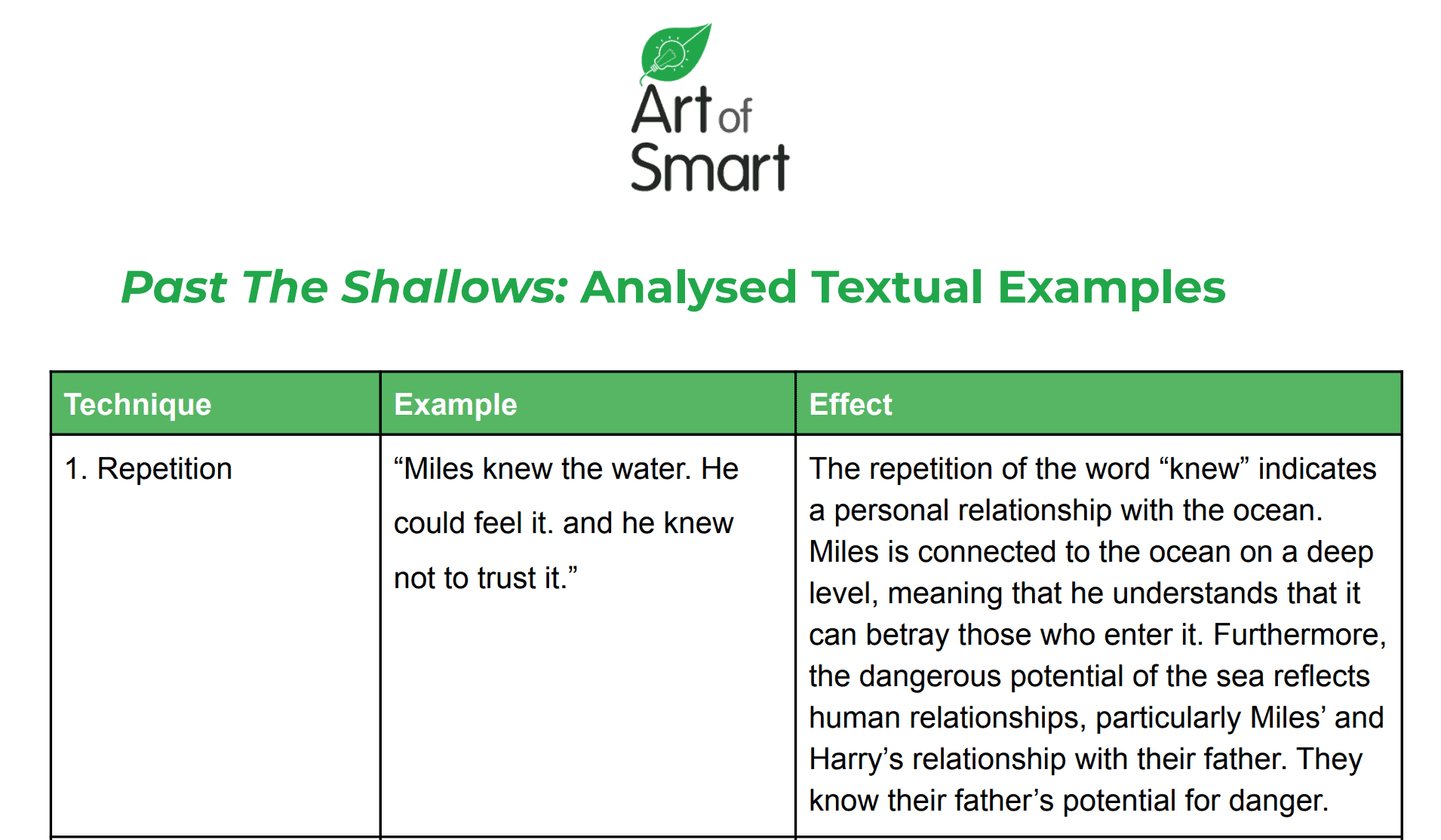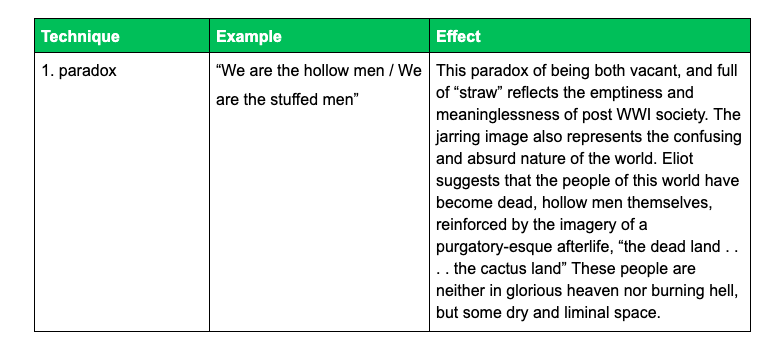Studying HSC English? Need to do an in-depth analysis of ‘Past the Shallows’ to craft a Band 6 worthy essay? Or just looking for a simple ‘Past the Shallows’ summary?
Well, you’ve come to the right place! We’re going to walk you through the key ideas in Past the Shallows, as well as give you a step-by-step of how to analyse a piece of text from Past the Shallows.
PLUS we’ll provide you with a sample analysis table (also called a TEE table) and a sample Band 6 paragraph for Past the Shallows!
If you’re more of a visual person, check out our video on how to analyse Past the Shallows!
Plus…before we get started, we should mention that our HSC English Tutors across the Hills District and wider Sydney know this text inside and out and can provide the personalised support you need! Get in touch!
So, what are you waiting for? It’s time to ace your analysis of Past the Shallows – let’s go!
Past the Shallows Summary
Key Characters in Past the Shallows
Context and Setting in Past the Shallows
Key Ideas/Themes in Past the Shallows
How Past the Shallows Links to Texts and Human Experiences
Analysis of Past the Shallows
Band 6 Paragraph and Analysed Examples
Past the Shallows Summary
Past the Shallows is about three brothers growing up on the Tasmanian coast with an abusive Father, Steven, an Abalone fisherman. Their Uncle Nick drowned on the same night that their mother died in a car crash. Joe, the oldest brother leaves home to live with their grandad.
After their grandad also dies, Joe attempts to sail away on a boat he has built. The two younger brothers, Miles and Harry are left to fend for themselves without the support of their uncle, mother or grandad. They rely on one another’s support to overcome the dangerous abuse of their father.
This abuse reaches a climax when Steven pushes Harry overboard their Abalone fishing boat, just as Miles uncovers the truth behind the death of his mother and uncle.
Key Characters in Past the Shallows
Harry Curren
The youngest and most innocent brother of the Curren family. Despite his father’s abuse, he remains loving to those around him in hopes that they might return it. His childish innocence made “made you promise to take care of him”.
Miles Curren
Miles is the middle child of the Curren family who bears the brunt of taking care of his younger brother, Harry. Though he is only thirteen at the start of hte book, Miles replaces Uncle Nick’s job of manning the boat and is consequently torn from his childhood.
Joe Curren
Joe is the eldest brother of the Curren family who leaves home to flee his abusive father. He stays at his grandfather’s home and follows in his grandfather’s footsteps in becoming a carpenter.
Steven Curren/Dad
He is the father of the three brothers, an Abalone fisherman who is struggling with alcoholism and trying to provide for his family. He is abusive to his sons, however is hinted to be once a loving father.
Mum
The loving mother of the Curren brothers died in a car crash before the novel begins. The novel reveals Uncle Nick and Mum were eloping on the night Mum’s car crashed.
Uncle Nick
Uncle Nick was Steve Curren’s ex-business-partner. He is rumoured to be Harry Curren’s biological sun as Mum and Uncle Nick were having an affair. On the night Mum’s car crashed, Uncle Nick was murdered by Dad murdered.
George Fuller
A man with scars on his face and hands who becomes a friendly father figure to Harry.
Summary of Context and Setting in Past the Shallows
Past the Shallows is set on the coastline of Tasmania in a place called Bruny Island. The Island is only small, and is located off the South East Coast of Tasmania.
The population of Bruny Island is approximately 600 people and its unpopulated areas are covered largely in Eucalyptus. Along many of the beaches are rugged cliffs and volcanic rocks up to 200 metres tall. The island is also a popular place for fishing and boating.
The Author of Past the Shallows, Favel Parrett, spent much of her time growing up on similar Tasmanian Beaches, searching for “treasures” that had been washed up on the shore. She loves to surf and the ocean plays a significant part in Parrett’s life and to a greater extent, her writing.
On this, she says: ”You could always smell the ocean – the salt and slight smell of rotting kelp in the air. . .To me, the setting became one of the main characters in the book, as it brings something dark, sad and ancient to the story.”
Summary of Key Ideas/Themes in Past the Shallows
Now, we’ll walk you through some of the key ideas/themes from ‘Past the Shallows’ and help you identify their link to ‘human experience’!
The key ideas include:
- The multifaceted nature of the ocean
- The importance of brotherhood
- The tragedy of abuse and addiction
- Dealing with grief
- Perceptions of monstrosity
Remember that now that you are in Year 12, you want to say something about the themes you are talking about.
So rather than talking about ‘monstrosity’, you should say something about the idea of monstrosity. For example, ‘society’s perception of monsters is radically different to the realities of characters’ hearts.’
How Past the Shallows Links to Texts and Human Experiences
Before you begin your analysis of Past the Shallows, it’s a good idea to read up on what the Common Module: Texts and Human Experiences is about so you know how to relate to the module in your assessment.
Let’s take a look at the syllabus!
In short, this module is about deepening your understanding of how texts represent the individual and collective human experience. This can include examining how texts represent human qualities and emotions associated with, or arising from human experiences.
You can read more about Texts and Human Experiences in our guide! Don’t forget to check out our recommended related texts too.
Below we are going to run through the key links between the Common Module Syllabus and Past The Shallows.
Link #1: The Paradoxical Nature of Family
Students explore how texts may give insight into the anomalies, paradoxes and inconsistencies in human behaviour and motivations . . .
In Past the Shallows, the role of family is paradoxical. In many ways family represents safety and intimacy. For example the brothers’ relationship with each other, their mother and granddad. However, their relationship with their father subverts this expectation as Steven is physically abusive, cruel and dangerous.
Link #2: Challenges Assumptions about Monstrosity
. . . inviting the responder to see the world differently, to challenge assumptions, ignite new ideas or reflect personally.
The contrast between Steven, the boys’ father, and George Fuller, the town ‘monster’, demonstrate that true monstrosity is not external, but intrinsic. Despite George’s deformities, harry finds a place of respite, love and protection in his home. On the other hand, his father, a figure that traditionally represents love and protection, is monstrous in reality.
Link #3: The Individual and Collective Human Experience of the Ocean
In this common module students deepen their understanding of how texts represent individual and collective human experiences.
The experience of the ocean in both individual and collective in past the Shallows. Each of the brothers’ experience the ocean in a different way. For Joe, it is a vessel for freedom, for Miles it is a place of beauty and grandeur and for Harry it is a place that represents fear and danger.
However, the ocean is also collective. The book describes to the ancient qualities of the ocean, alluding to the fact it has been experienced by people and cultures since the beginning of time. This message is reiterated by the final comment that:
Harry was free to stay here now. Free to run along this beach until the end of time.
This suggests that the ocean is capable of preserving the souls of those lost at sea, making it a universal afterlife for all those whom it has swallowed.
On the hunt for practice questions for the common module? Check out our list of essay questions!
How to Analyse Past the Shallows in 3 Steps
Often students will try to start with their thesis when trying to answer an essay question. Instead, start with your analysis! You need to equip yourself with the knowledge of your text before you can answer anything about it.
After you’ve analysed your text, you can draw ideas from it, then you can build your thesis!
Below, we are going to analyse some examples to show the duality of nature in Past the Shallows.
Step 1: Choose your example
It is important to find an example that demonstrates one stage of your argument. Remember that each of your examples should not be saying the exact same thing. They should show different facets of your topic sentence.
If you’re on the hunt for quotes to use for analysis from Past the Shallows, we have a whole lot for you to save!
In the example below we have shown the dangerous qualities of nature:
“Miles knew the water. He could feel it. and he knew not to trust it.”
Step 2: Identify techniques
When trying to find a technique within your quote, it’s not about finding the fanciest technique or just any old technique for that matter!
It’s about identifying a technique which will enable you to say something about your idea that’s interesting and can contribute to your argument and analysis.
That’s why we’ve chosen the two techniques below, which we will show the effect of in step 3!
- Repetition
- Symbolism
Remember that it is useful to point out multiple techniques in a quote, so long as you show what the effect of each technique is.
If you need to brush up on your literary techniques, check out this cheat sheet of literary techniques to help you analyse Past the Shallows!
Step 3: Carry out your analysis
Now that you’ve identified your techniques, you need to conduct some analysis!
Did you know the key to good analysis is starting with a technique? You focus on the technique and identify what it reveals about an idea.
Good analysis involves using a technique to say something in addition to what the quote says.
Bad analysis is using a technique to restate what happened in the quote.
It usually sounds something like this: “Therefore [technique] shows [your idea]”, without going into any real depth.
What do the techniques of repetition and symbolism show in Past the Shallows?
Repetition
The repetition of the word “knew” indicates a personal relationship with the ocean. Miles is connected to the ocean on a deep level, meaning that he understands that it can betray those who enter it.
Symbolism
The water symbolises the relationship and the complexity of the relationship that Miles has with his father. He knows his father and he knows equally not to trust him.
Now, let’s organise our analysis by placing it in a TEE table like below!
Sample Band 6 Paragraph and Analysed Examples
We’ve analysed another two examples using TEE tables that relate to the theme of individuality in Past the Shallows that you can access below!
We’ve also got a sample Band 6 paragraph that you can read over in our downloadable guide below!
Need some help with your analysis of other texts?
Check out other texts we’ve created guides for prescribed texts below:
- Billy Elliot
- Keats and Bright Star
- The Crucible
- King Henry IV Part 1
- All the Light We Cannot See
- The Union Buries its Dead
- I Am Malala
Looking for some extra help with your analysis of Past the Shallows?
We have an incredible team of HSC English tutors and mentors who are new HSC syllabus experts!
We can help you master your analysis of Past the Shallows and ace your upcoming HSC English assessments with personalised lessons conducted one-on-one in your home or at one of our state of the art campuses in Hornsby or the Hills!
Dive into Past the Shallows with Epping Tutoring or Wollongong Tutoring Or allow one of our HSC English tutors in Hurstville to immerse you deeper into the story!
We’ve supported over 8,000 students over the last 11 years, and on average our students score mark improvements of over 20%!
To find out more and get started with an inspirational HSC English tutor and mentor, get in touch today or give us a ring on 1300 267 888!
Brooklyn Arnot has a Bachelor of Arts majoring in English Literature with Honours at the University of Sydney. She scored an HD average and has even received the Dean’s Award for Excellence! Brooklyn teaches our English classes at Art of Smart and has over 5 years of experience supporting Year 11 and 12 students throughout their HSC. She’s also a new syllabus expert and studied Extension 2 English in high school.








